HOW TO FIND THE QUOTIENT WHEN DIVIDING POLYNOMIALS
Following are the two methods can be used to find the quotient when dividing polynomials.
1. Synthetic division
2. Long division
Question 1
Find the quotient and remainder using synthetic division.
(x3 + x2 - 3 x + 5 ) ÷ ( x - 1 )
Solution :
Let p(x) = x3 + x2 - 3x + 5 and q(x) = x - 1. We can find the quotient s(x) and the remainder r, by proceeding as follows.
q(x) = 0
x - 1 = 0
x = 1
Step 1 :
Arrange the dividend and the divisor according to the descending powers of x and then write the coefficients of dividend in the first zero. Insert 0 for missing terms.
Step 2 :
Find out the zero of the divisor.
Step 3 :
Put 0 for the first entry in the second row.
Step 4 :
Write down the quotient and remainder accordingly. All the entries except the last one in the third row constitute the coefficients of the quotient.
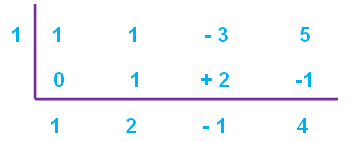
When P(x) is divided by (x - 1),
Quotient = x² + 2 x - 1
Remainder = 4
Question 2 :
Find the quotient and remainder using synthetic division
(3x3 - 2x2 + 7 x - 5) ÷ (x + 3)
Solution :
Let p (x) = 3x3 - 2x2 + 7 x - 5 be the dividend and q (x) = x + 3 be the divisor. We shall find the quotient s(x) and the remainder r, by proceeding as follows.
q(x) = 0
x + 3 = 0
x = - 3
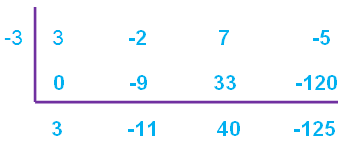
When P (x) is divided by (x + 3), the quotient is 3 x² - 11 x + 40 and the remainder is - 125.
Quotient = 3x2 - 11 x + 40
Remainder = - 125
When we want to divide a given polynomial by another polynomial, first we have to write the dividend inside the long division sign from highest degree to lowest degree.
For example, the highest degree of the polynomial is 3, then the next term of the dividend must be the square term and so on. In this, if we don't have square term, we have to write 0 instead of that and we can write the next term.
Let us see some example problems based on the above concept.
Question 3 :
Find (a3 + 8a - 24) ÷ (a - 2)
Solution :
The degree of the given polynomial is 3 then we must have square term. But here we don't have square term, so we have to replace it by 0.
Step 1 :
In the first step, we have to divide the first term of the dividend by the first term of the divisor.
If we divide a3 by a, we will get a2. We have to write a2 at the top and multiply each term of the dividend by a².
a2(a - 2) = a3 - 2a2
By subtracting a3 - 2a2 from (a3 + 8a - 24), we get 2a2 + 8a + 24.
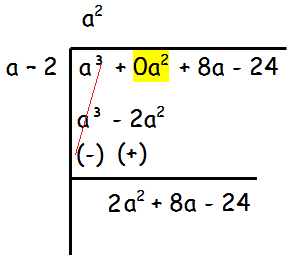
Step 2 :
Now we have to divide 2a2 by a, so we will get 2a.
- By multiplying this 2a by (a - 2), we get 2a2 - 4a.
- By subtracting 2a2 - 4a from 2a2 - 8a - 24, we get 12a - 24
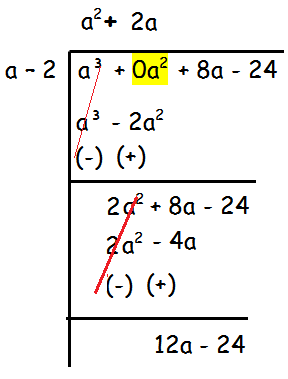
Step 3 :
Divide 12a by a, so we get 12.
- By multiplying this 12 by (a - 2), we get 12a - 24.
- By subtracting 12a - 24 from 12a - 24, we get 0.
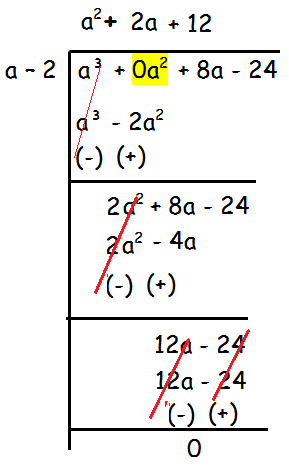
Hence,
Quotient = a2 + 2a + 12
Remainder = 0
Question 4 :
Find (4x3 + 2x2 - 5) ÷ 2x
Solution :
The degree of the given polynomial is 3. But here we don't have x term, so we have to replace it by 0.
Step 1 :
In the first step, we have to divide the first term of the dividend by the first term of the divisor.
If we divide 4x3 by 2x, we will get 2x2.
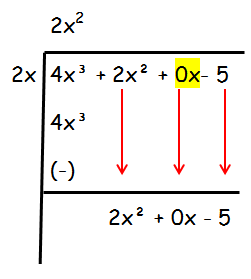 |
|
Step 2 :
Now we have to divide the first term of the dividend 2x2 by 2x, so we get x.
- By multiplying x by 2x, we get 2x3.
- Subtracting 2x2 form 2x2, we get 0
- Bring down the next term, we get -5
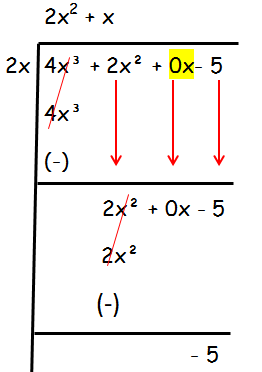
Hence,
Quotient = 2x2 + x
Remainder = -5
Kindly mail your feedback to v4formath@gmail.com
We always appreciate your feedback.
©All rights reserved. onlinemath4all.com
Recent Articles
-
Digital SAT Math Problems and Solutions (Part - 144)
Apr 14, 25 07:27 PM
Digital SAT Math Problems and Solutions (Part - 144) -
Quadratic Equation Problems with Solutions (Part - 1)
Apr 14, 25 11:33 AM
Quadratic Equation Problems with Solutions (Part - 1) -
Quadratic Equation Problems with Solutions (Part - 2)
Apr 14, 25 11:22 AM
Quadratic Equation Problems with Solutions (Part - 2)
